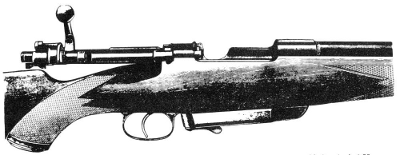The following information on Mauser-type rifles and the German anti-tank rifle comes from Chapter 27 of Mauser Rifles and Pistols by W. H. B. Smith. Mauser Rifles and Pistols is also available to purchase in print.
Rifles manufactured on the Mauser system were very common in Europe. In military calibers, they were manufactured by Fabrique Nationale at Herstal, in Belgium, particularly in calibers 7.9mm—the standard German army cartridge. However, they were manufactured to order in all military calibers.
Weapons of this caliber and of design practically identical with the German Kar. 98 were also manufactured at the official arms works at Brno, in Czechoslovakia. These Czech rifles are of very superior manufacture, and were made in sporting as well as military type. Yugoslavia also built them from 1924 on.
Rifles of this same design for military purposes, were also manufactured at Radom, an official arsenal in Poland. The Polish weapons were excellent rifles, but crude in workmanship by comparison with high German standards.
Mauser rifles are also manufactured at the Spanish arsenal at Oviedo, Spain, in Mexico City, Mexico, and in the Argentine. Some were also manufactured in China. All these rifles were manufactured with equipment purchased from Germany, and in accordance with German specifications.
The Mexican Mauser in particular, is an excellent weapon made of the finest material and workmanship.
As already stated, the great Steyr Works, in Austria, also manufactured Mauser-type rifles in large quantity for export to foreign government.
The Schueler Mausers
In the field of large caliber high priced sporting rifles, the Mauser action has been adapted very widely. Perhaps the finest of these adaptations is that by Schueler at Suhl, Germany. Most of these rifles, like the genuine Waffenfabrik Mausers, have magazines containing 5-cartridges. Barrels may be partly octagon and partly round.

1. Type I has a 24-inch barrel with matted top rib. A tangent curve sight can be regulated up to 1000 meters. Other types of rear sights are used however. These rifles were manufactured for the following calibers; 6.5x54mm (.256), 7x57mm (.276), 8x57mm (.315) and 9x57mm (.355).
Other calibers in which some models of this rifle were manufactured are: 9.3×62 mm (.360) and 10.75×68 mm (.423).
2. Another rifle of this same design but of simpler finish with a round barrel was also made for the above cartridges. Special rifles in these types were chambered for .250-3000 Savage, .280 Ross, .30-06 U.S., .318 W.R., .404 British Eley, and for special German high power cartridges such as the 8x60mm ( .315) Magnum, and 9.3x62mm ( .366) Magnum.
3. Special “Schueler Magnum” rifles on the Mauser action were made in several types. One type with set trigger had a stock extending to the muzzle, while another had the customary sporting half-length fore-stock.
These rifles were manufactured for the following cartridges: 7x64mm (.275) and 8×64 mm (.315) (7×64 is a special Magnum).
The “Schueler Magnum” magazine held only four cartridges, but a fifth could be inserted directly in the chamber. These rifles were made for the 11.2x72mm (.441) Schueler cartridge, usually with set triggers. A modification of this rifle for elephant and rhino hunting, still more heavily built than the other, used the .500 Schueler cartridge. This cartridge had a muzzle velocity of 2460 feet per second with a striking energy of 7230 foot pounds. It is one of the most powerful rifles ever designed. The magazine extends below the bottom of the stock and has a lever release. This rifle was made with single trigger, and was designed for African and Indian big game shooting.
Schilling, Haenel and other manufacturers at Suhl made fair to good imitations of the genuine Mauser. Practically all of these were for standard German cartridges. Simson built fine rifles.
In England, Rigby made rifles on Mauser actions in calibers .275 High Velocity, .350 Magnum, .416 Big Game. These rifles retailed in the United States from $250 to about $400.00.
The British Jeffery rifles are also of Mauser pattern and use a series of special British cartridges including the .333 Jeffery, .375 Magnum, .400 Jeffery, .404 Jeffery, .450 No.2, .475 No.2, .500 Rimless, 577-3 inch, and .600.
These Jeffery’s, are rifles of first line workmanship and quality and sold in the United States from $350.00 to $400.00 or more.
Other fine British manufacturers of rifles on the Mauser system, are Westley Richards (whose most famous model is the .425 W.R.) and Holland & Holland. H. & H. are particularly known for their .375 cartridge, and also for their .24 Apex. These rifles sell in the class of $275.00 and up. Vickers rifles are commonly .242 or .318.
Other Mauser Rifles—German Anti-Tank Rifle
During World War I, the Germans manufactured a drill rifle having a cast receiver and a pipe barrel. There were no working parts in this model, which was intended strictly for instruction purposes.
The German Anti Tank Rifle, Model 1918, was made at Oberndorf, in caliber 13mm. It weighed 30 pounds, was 5.5-feet long, and was fired from a bipod. In its day it was a deadly and efficient weapon, capable of long range precision shooting. The cartridge it employed closely resembled the later developed famous United States .50 caliber Browning cartridge used in World War II.


In World War II Mauser designed and manufactured a limited number of semiauto gas-operated rifles known as 41-M. Gas expanding in a muzzle cone was trapped and some diverted to drive back a piston to unlock and function the action. This rifle was clip loaded. Capacity was 10 cartridges, 7.92mm. The rifle was heavy and clumsy and the gas action fouled so badly that the design was soon abandoned.
